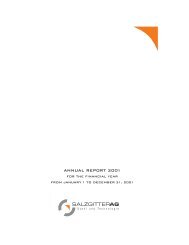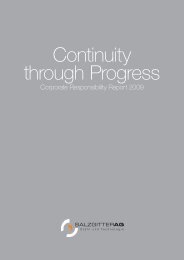Download - Salzgitter AG
Download - Salzgitter AG
Download - Salzgitter AG
Create successful ePaper yourself
Turn your PDF publications into a flip-book with our unique Google optimized e-Paper software.
B Consolidated Annual Financial Statements/Notes V. Notes to the Consolidated Financial Statements of <strong>Salzgitter</strong> <strong>AG</strong> 230 231<br />
In the case of financial instruments that are classified as “available-for-sale financial assets”, a material or<br />
permanent decrease in the fair value is posted to income as an impairment. Impairments of equity instruments<br />
that have already been recorded in the income statement are reversed with no effect on income,<br />
while impairments of debt instruments are reversed with effect on income.<br />
Financial instruments are written off when the rights to payments from the investment have lapsed or<br />
been transferred and the Group has essentially transferred all of the risks and opportunities associated<br />
with their ownership.<br />
Inventories<br />
Inventories are stated at acquisition or production cost or the lower net selling value. Inventories are<br />
valued at average costs or individually attributed acquisition or production costs. The production costs<br />
are determined on the basis of normal capacity utilization. Specifically, the production costs include<br />
not only the directly attributable costs, but also the production-related material costs and production<br />
overheads including production-related depreciation. Borrowing costs are not capitalized as part of<br />
acquisition or production costs. Lower values as of the reporting date resulting from the decrease<br />
in net selling values are stated. If the net selling value of previously written-down inventories<br />
has increased, the resultant reversal of write-downs is recorded as a reduction in the cost of materials<br />
or a change in inventories.<br />
All discernible storage and inventory risks that impact the expected net selling value are taken into<br />
account by applying properly calculated value adjustments.<br />
Work in process and finished products, as well as raw materials internally generated, are valued at<br />
Group production cost which, in addition to direct costs, includes the variable and fixed overhead<br />
costs that are calculated systematically or attributed.<br />
Rights to emit CO2 gases are reported in the balance sheet under inventories (consumables and supplies).<br />
Initial ownership of emission rights that were acquired gratuitously are recorded at an acquisition<br />
cost of € 0. Emission rights acquired against payment are recorded at acquisition cost. Increases<br />
in the value of the capitalized emission rights are realized only in the event of a sale. Impairments of<br />
the capitalized emission rights are recorded when the market price of the emission rights has fallen<br />
below the acquisition cost.<br />
Trade Receivables<br />
Trade receivables are initially recognized at fair value and subsequently measured at amortized cost<br />
using the effective yield method, less impairments. An impairment of trade receivables is reported<br />
when there is objective evidence that the Group will not be able to collect all of the amounts due. The<br />
amount of the impairment corresponds to the difference between the book value of the receivable<br />
and the net present value of the estimated future cash flows from the receivable, discounted at the<br />
effective interest rate. The impairment is disclosed in the income statement.<br />
Consolidated Annual<br />
Financial Statements











